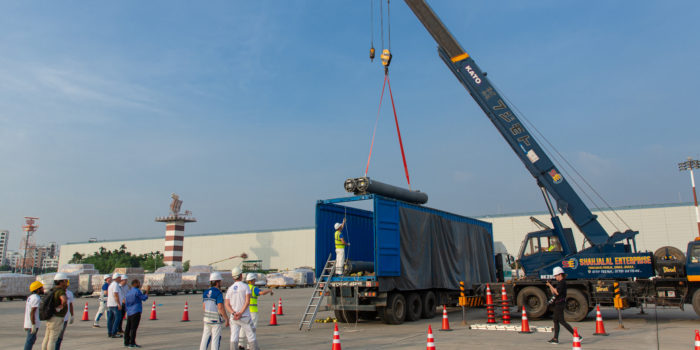The Murmansk Region closes the more than ten-year history of the dismantlement of the Lepse Floating Technical Base (FTB), which supported the operation of the first nuclear-powered icebreakers and the spent nuclear fuel storage facility of which has posed a significant environmental risk to the region for many years. The last – bow – unit packaging with decontaminated fragments of the ship has been placed in the Sayda-Guba reactor compartment storage facility.
At a gala event dedicated to the project completion, Andrey Nikipelov, Rosatom’s Deputy Director General for Mechanical Engineering and Industrial Solutions, noted: “Rosatom undertakes the solution of the most complex environmental problems: we are eliminating the nuclear legacy and the toxic industrial production legacy and creating the radiation and chemical waste management infrastructure in the country. For more than 20 years, we have systematically cleaned the coast of the Arctic and the Far East from radiation-hazardous objects – disposed of decommissioned nuclear-powered submarines and auxiliary ships. And in this sense, today is a special day for us: one of the Rosatom’s landmark environmental projects – the dismantlement of the Lepse Floating Technical Base – has been completed. Now there is one hazardous object fewer in the Arctic.”
The major radioactive hazard at the Lepse FTB was its spent nuclear fuel (SNF) storage facility. The SNF discharging and removal from the floating base outside the region – 639 fuel assemblies some of which were damaged (meaning they could not have been removed from the ship by conventional means), required special engineering solutions from nuclear industry experts.

In particular, to discharge spent nuclear fuel, the Lepse was placed in a specially designed and built onshore sheltering site. This made it possible to prevent any weather effects such as sea disturbance and precipitation. A technology was invented to discharge fuel together with the storage cell shell so that to prevent fuel assemblies from collapsing during the discharge process. This required to design and manufacture special tools and tackle. The work was carried out using a remote-controlled robotic unit.
Various organizations of the atomic industry and enterprises of the North-West took part in the implementation of the project. Now, any ship fragments no longer pose a danger; additional bioshield is installed on them from the outside, which will ensure safety during long-term storage. In the Murmansk Region, spent nuclear fuel removal is underway as planned. From 2002 to 2023, the total volume of accumulated SNF has been halved. The remaining SNF is being removed from the storage facility in Gremikha; all the work is expected to be completed in 2025. More than one half of the SNF has already been removed from the Andreev Bay facility, and the work is planned to be completed by 2028.





